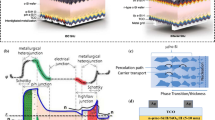Abstract
We present experimental and theoretical characterization of InP-based heterostructure integrated thermionic (HIT) coolers. In particular, the effect of doping on overall device performance is characterized. Several thin-film cooler devices have been fabricated and analyzed. The coolers consist of a 1μm thick superlattice structure composed of 25 periods of InGaAs well and InGaAsP (λgap ≈ 1.3μm) barrier layers 10 and 30nm thick, respectively. The superlattice is surrounded by highly-doped InGaAs layers that serve as the cathode and anode. All layers are lattice-matched to the n-type InP substrate. N-type doping of the well layers varies from 1.5×1018cm−3 to 8×1018 cm−3 between devices, while the barrier layers are undoped. Device cooling performance was measured at room-temperature. Device current-versus-voltage relationships were measured from 45K to room-temperature. Detailed models of electron transport in superlattice structures were used to simulate device performance. Experimental results indicate that low-temperature electron transport is a strong function of well layer doping and that maximum cooling will decrease as this doping is increased. Theoretical models of both I-V curves and maximum cooling agree well with experimental results. The findings indicate that low-temperature electron transport is useful to characterize potential barriers and energy filtering in HIT coolers.
Similar content being viewed by others
References
L. Rushing, A. Shakouri, P. Abraham, and J. Bowers, “Micro Thermoelectric Coolers for Integrated Applications”, 16th International Conference on Thermoelectrics, 1997, pp. 646–649.
A. Shakouri and J. Bowers, “Heterostructure Integrated Thermionic Refrigeration”, 16th International Conference on Thermoelectrics, 1997, pp. 636–640.
A. Shakouri and J. Bowers, Appl. Phys. Lett. 71(9) 1234 (1997).
G.D. Mahan and L.M. Woods, Phys. Rev. Lett. 80, 4016 (1998).
T. Zeng and G. Chen, “Energy Conversion in Heterostructures for Thermionic Cooling”, Microscale Thermophysical Engineering, 4, pp. 39–50.
A. Shakouri, C. LaBounty, P. Abraham, J. Piprek, and J. Bowers, “InP-based Thermionic Coolers”, 11th International Conference on Indium Phosphide and Related Materials, 1999, pp. 463–465.
A. Shakouri, C. LaBounty, P. Abraham, J. Piprek, and J.E. Bowers, “Enhanced Thermionic Emission Cooling in High Barrier Superlattice Heterostructures”, Mat. Res. Soc. Symp. Proc. 545, 1999, pp. 449–458.
D. Vashaee and A. Shakouri, “Improved Thermoelectric Power Factor in Metallic-based Superlattices”, submitted for publication in Physical Review Letters, 2003.
D. Vashaee and A. Shakouri, “Modeling and Optimization of Single-element Bulk SiGe Thin-film Coolers”, submitted for publication in Microscale Thermophysical Engineering, 2003.
D. Vashaee and A. Shakouri, “Electronic and Thermoelectric Transport in Semiconductor and Metallic Superlattices”, tentatively scheduled for publication in Journal of Applied Physics on February 2004.
Author information
Authors and Affiliations
Rights and permissions
About this article
Cite this article
Singh, R., Vashaee, D., Zhang, Y. et al. Experimental Characterization and Modeling of InP-based Microcoolers. MRS Online Proceedings Library 793, 87–93 (2003). https://doi.org/10.1557/PROC-793-S11.4
Published:
Issue Date:
DOI: https://doi.org/10.1557/PROC-793-S11.4




